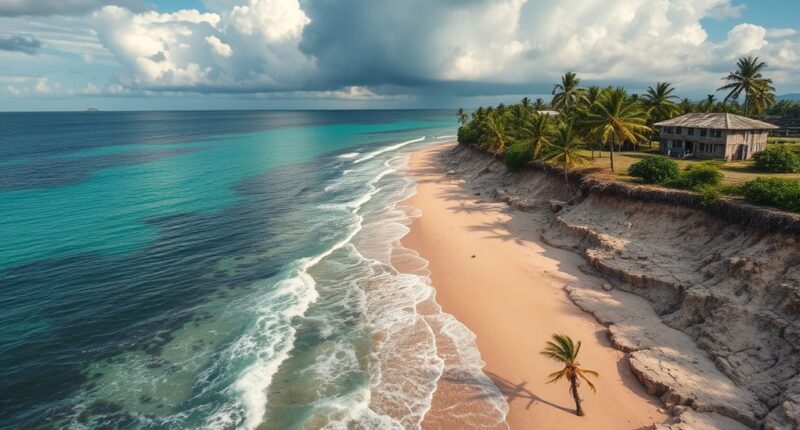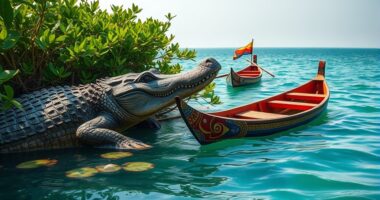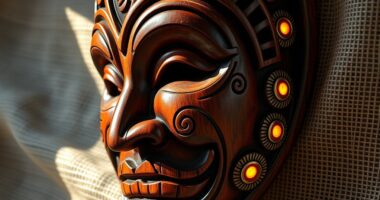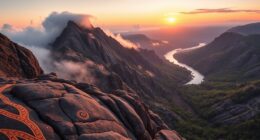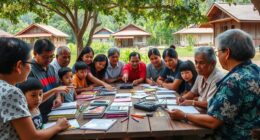On Saibai Island, climate change is forcing communities to confront rising sea levels and coastal erosion directly impacting their land, culture, and way of life. You’ll see how seawalls are built and efforts are made to restore natural barriers, but these struggles highlight the urgent need for action. As the ocean encroaches further, understanding how these stories unfold will help you realize the full scope of this global crisis.
Key Takeaways
- Saibai Island faces severe land loss and erosion due to rising sea levels caused by climate change.
- Coastal communities experience frequent flooding, threatening homes, infrastructure, and traditional cultural sites.
- Rising seas contaminate freshwater supplies and increase saltwater intrusion, impacting daily life and health.
- Local efforts include constructing seawalls and restoring natural barriers like mangroves to enhance resilience.
- Elders warn parts of Saibai could become uninhabitable within decades, highlighting urgent climate action needs.
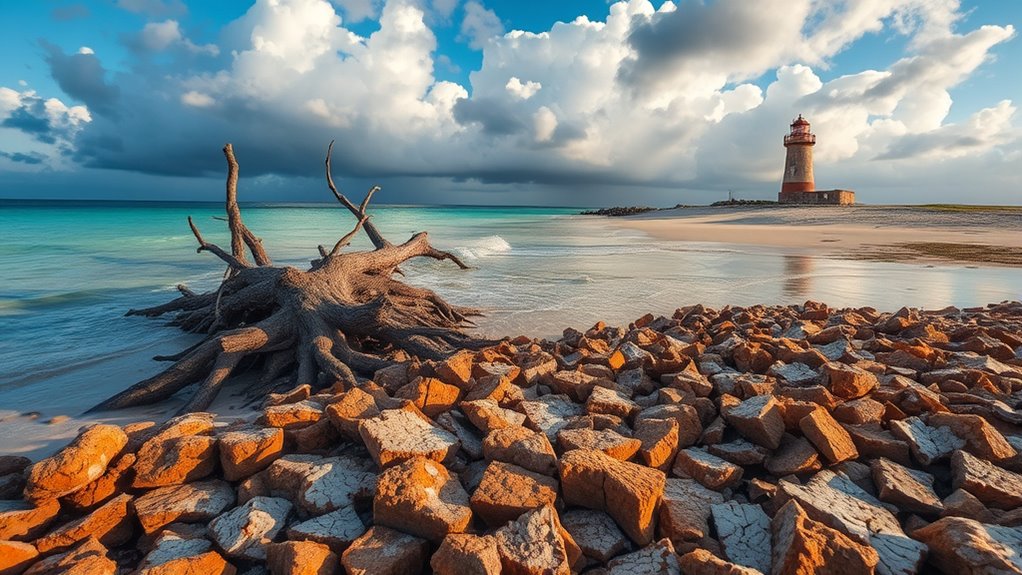
Have you ever wondered how climate change is affecting remote communities like Saibai Island? This small island, part of Australia’s Torres Strait, is on the frontline of rising seas and changing weather patterns. The impacts are immediate and tangible, forcing residents to adapt to a new reality. One of the most pressing issues is sea level rise. As global temperatures climb, polar ice melts and seawater expands, causing the ocean to encroach on land at an alarming rate. For Saibai Island, this means the shoreline is constantly moving inward. You can see it in the shrinking beaches and the loss of essential land that once supported homes and cultural sites. Coastal erosion worsens with each passing year, steadily eating away at the island’s edges. The shoreline that used to be a comfortable distance from the community is now just meters away from the sea. This erosion not only threatens property but also jeopardizes traditional ways of life. The land holds cultural significance for the local people, and losing it means losing part of their identity. Rising sea levels threaten not only the physical landscape but also the cultural heritage that defines the community.
The frequent flooding and higher water levels make it difficult for residents to carry out daily activities. Roads become impassable, and saltwater intrusion contaminates freshwater supplies. This creates a cycle of hardship where communities face increased costs and logistical challenges in accessing clean water and resources. School buildings and health clinics, which are essential for community well-being, sit closer to the shoreline, making them vulnerable to storm surges and rising tides. You might see families spending time repairing sea walls or relocating structures to higher ground, efforts that cost time and money but are necessary to protect their homes. The threat of coastal erosion doesn’t just diminish land; it erodes the community’s stability and sense of security. The island’s elders warn that if current trends continue, parts of Saibai could become uninhabitable within decades.
Despite these challenges, the community is resilient. They’re working with scientists and government agencies to find solutions, such as building seawalls and restoring natural barriers like mangroves, which can help absorb wave energy. But these measures are only part of the fight. The core issue remains: climate change is accelerating the loss of land and altering life on Saibai Island in ways that are hard to reverse. You can’t ignore the fact that what’s happening here reflects a global crisis—one that demands urgent action. For the residents of Saibai, climate change isn’t just an abstract concept; it’s a daily struggle to preserve their homes, culture, and way of life in the face of rising seas and relentless erosion.
Frequently Asked Questions
How Are Local Communities Adapting to Rising Sea Levels?
You see that local communities are actively adapting to rising sea levels through a mix of Indigenous practices and coastal management strategies. They incorporate traditional knowledge to build resilient structures and protect their land, while also implementing modern coastal management techniques like seawalls and mangrove planting. This combination helps safeguard their homes and environment, ensuring their way of life continues despite the challenges posed by rising seas.
What Traditional Knowledge Supports Climate Resilience on Saibai Island?
You can see that traditional knowledge plays a crucial role in supporting climate resilience on Saibai Island. Indigenous practices, like sustainable fishing and land management, help protect the environment. Cultural preservation keeps these practices alive, ensuring they adapt to changing conditions. By valuing these traditions, you support a community that relies on its heritage to face challenges, strengthening resilience through age-old wisdom and sustainable living methods.
Are There International Efforts Aiding Saibai’S Climate Adaptation?
Sure, international efforts are rolling in like clockwork, promising to save Saibai Island from drowning—if only they’d actually listen. You’ll find numerous partnerships and policy initiatives aimed at climate adaptation, but often, they’re more talk than action. Still, these collaborations bring hope, offering resources and expertise. Keep an eye out; the world might just pull through with the right international support, or at least try to pretend they are.
How Does Climate Change Affect Saibai’S Biodiversity and Ecosystems?
You see that climate change impacts Saibai’s biodiversity and ecosystems by causing coral bleaching and mangrove decline. These changes threaten marine life and coastal protection, disrupting habitats for fish, birds, and other species. As temperatures rise, corals lose their vibrant colors, and mangroves struggle to survive, reducing biodiversity. These shifts weaken ecosystems’ resilience, making Saibai more vulnerable to storms and sea-level rise, ultimately endangering the island’s ecological balance.
What Are the Long-Term Projections for Saibai’S Environmental Changes?
You’ll see that sea level rise and coastal erosion are expected to worsen over the long term on Saibai Island. These changes threaten your community’s land, homes, and local ecosystems. As sea levels continue to rise, erosion will accelerate, making it harder to protect your environment. If current trends persist, these environmental shifts could profoundly impact your way of life, emphasizing the urgent need for adaptation and resilience efforts.
Conclusion
As you stand on Saibai Island, you can almost see the rising tides swallowing the shoreline like an unforgiving tide of time. Climate change isn’t just a distant threat; it’s knocking at your door, threatening to erase this paradise. But your actions can turn the tide—by protecting this fragile land, you become the lighthouse guiding it through the storm. Together, you hold the power to keep Saibai shining brightly, even in the darkest of times.
Mary is a passionate writer who brings creativity and a fresh perspective to our team. Her words have the power to captivate and inspire, making her an essential contributor to our content. Mary’s commitment to storytelling and dedication to promoting Indigenous culture ensures that her work touches the hearts of our readers. We’re fortunate to have her as part of our team.
